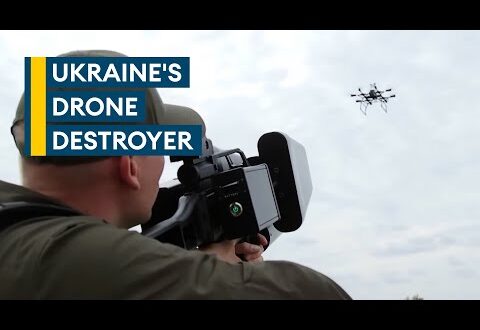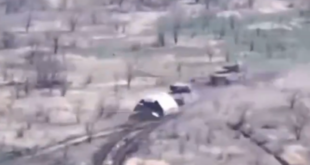The threat of small drones and how they are implemented has changed the way the military trains for war. Some drones are used as a reconnaissance platform for detecting troop movements, while others are rigged with hardware to drop grenades and mortars on enemy fighters.
Either way, small commercial drones will be a permanent fixture in modern warfare.
“Talk to any soldier in Ukraine,” said Brig. Gen. Guillaume Beaurpere, commander of the U.S. Army John F. Kennedy Special Warfare Center and School (SWCS). “You don’t go anywhere without a drone flying either in support of you or against you.”
First-person view (FPV) drone footage and other videos have poured onto social media feeds since Russia invaded Ukraine in early 2022. The videos have put the horrors of war on center stage as Russians and Ukrainians have been stalked and killed by off-the-shelf, modified small drones.
“What we are seeing these things used as today is a lot of reactive adaptation of technology. So, in the war in Ukraine, we’re seeing both sides kind of adapting to the disruptive nature of this tech,” said Dylan Hamm, a former Navy SEAL who currently works for PDW, a defense contractor focused on drone technology. “They’re figuring out: ‘What, can I zip tie to this drone?’ ‘How can I get this kinetic payload delivered?’ And they’re just making it happen.”
Small drones have played a major role during the war in Ukraine. Hamm said there have been several instances of quadcopters being rigged up with an RPG-7 rocket, modified from a direct, shoulder-fired weapon to a “maneuverable shape charge” that creates a nightmare for armored vehicles.
“That’s kind of flipped all strategy up on its head because now what do you do? How do you counter that capability?” Hamm said. “How do you protect folks against it? And how do you employ that capability on your own side to the greatest effect?”
Small unmanned systems
Dylan Hamm spent 12 years in the Navy and deployed to locations around the world eight times. But it wasn’t until later in his career that he started seeing the use of small unmanned systems.
“As I got toward the end of my time — 2017 through 2020 — we really started to see kind of the disruptive nature of small unmanned systems. I mean, we’ve always had larger systems like ScanEagle that we had in [Operation Enduring Freedom], which was able to provide us route clearance […],” Hamm said. “But it wasn’t until the implementation of those really small quadcopters and things of that nature that we started to see how capable these systems were.”
Hamm dove head first into the technology and explored their capabilities to see how the technology could support the missions they were conducting.
Subscribe to Task & Purpose today. Get the latest military news and culture in your inbox daily.
“That included design, fabrication, prototyping, configuration, tuning, deployment—all of it,” Hamm said. “So, with that, I kind of learned a good amount of that holistic process of product design, and I carried that with me as I transitioned out [of the Navy] in 2020.”
It wasn’t just the small off-the-shelf quadcopters that he was experimenting with and evaluating. He was testing unmanned, track-driven technologies as well. But, he found the small drones had a more agile and practical use for their missions.
“The small unmanned aerial systems have quite a bit more agility,” Hamm said. You can go up and over and around obstacles where the track ground vehicles are great. They have endurance, but they do have quite a bit of limitations in their ability to maneuver.”
Defense against small unmanned systems
There are several tactics employed throughout Ukraine to mitigate the risk of drone attacks, including weird-looking ‘guns’ that look like something straight out of a sci-fi movie.
Hamm thinks the technology is still in the early stages of development. The devices are fairly static and designed and developed to target certain frequency ranges or identify and target certain protocols, like a commercial DJI drone. The electromagnetic pulse weapon sends out DJI’s protocol command, forcing a drone to land or disarm.
“[the electromagnetic pulse weapons] lack a certain amount of agility. What we’re seeing overseas right now is really that cat-and-mouse game every week. Folks are innovating, changing the frequency bands they’re operating in, and changing the protocols they’re using,” Hamm said. “So, I think those systems are going to have to become more agile or just be iterated upon to continue to keep up with these changes.”
Hamm said tactics and fortifications are being changed to help ward off the threat of small unmanned drones. Nets are being implemented as a means to safely intercept a quadcopter, preventing it from delivering an impact-detonated munition.
Trench warfare is a major part of the war in Ukraine. The presence of drones changed the approach from tactics used during World War I and II.
“I don’t want a long linear trench if a quadcopter is going to come in at a long linear approach to deliver a kinetic payload,” Hamm said.
But with every change in tactics and every new technology implemented, there needs to be a comprehensive understanding of how to use it and how it can affect troops on the ground. For example, Hamm said jamming technology may be able to down a drone, but that could risk detonating the attached explosives when it hits the ground.
“I don’t know that there is a safe way in that implementation to down one of those drones without really risking those contacting each other and activating the device,” Hamm said.
Drone effects on military communication
In addition to jamming technology, cell phone towers and infrastructure emitting high energy levels can disrupt radio signals by disrupting operational frequencies.
PDW was recently awarded a $6.9 million contract from the U.S. Special Operations Forces Acquisitions, Technology, and Logistics (ATL) office for its jammer-proof radio technology, BlackWave. This helps ensure a reliable digital radio link in both intentional and unintentional jammed spaces. Due to the sensitive nature of that contract, Hamm was unable to elaborate on the new tech.
“I think it’s well suited for that particular conflict,” Hamm said. “They’re operating in trench warfare with artillery, and these systems are the disruptive tool they need to clear trenches and maneuver ground forces.”
Whether it’s different trench-clearing procedures or installing drone-stopping mesh over your armored vehicle, understanding the strengths and weaknesses of unmanned drones is a vital skill both Ukraine and the U.S. militaries are working to master.
“Everybody’s taking notes, adjusting tactics, figuring out how they can resource against it, and how they can potentially change unit structures to support these capabilities,” Hamm said. “Ukraine stood up an unmanned systems branch of their armed forces because they are fully invested in this capability.”
 Unmanned Aerial Vehicle The latest drone news
Unmanned Aerial Vehicle The latest drone news



